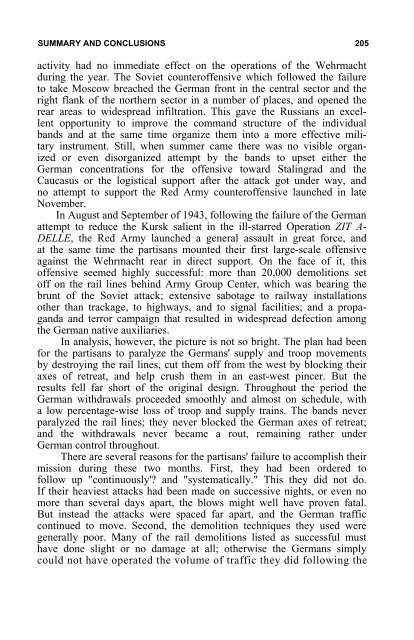the soviet partisan movement 1941-1944 by edgar m. howell
the soviet partisan movement 1941-1944 by edgar m. howell
the soviet partisan movement 1941-1944 by edgar m. howell
You also want an ePaper? Increase the reach of your titles
YUMPU automatically turns print PDFs into web optimized ePapers that Google loves.
SUMMARY AND CONCLUSIONS 205<br />
activity had no immediate effect on <strong>the</strong> operations of <strong>the</strong> Wehrmacht<br />
during <strong>the</strong> year. The Soviet counteroffensive which followed <strong>the</strong> failure<br />
to take Moscow breached <strong>the</strong> German front in <strong>the</strong> central sector and <strong>the</strong><br />
right flank of <strong>the</strong> nor<strong>the</strong>rn sector in a number of places, and opened <strong>the</strong><br />
rear areas to widespread infiltration. This gave <strong>the</strong> Russians an excellent<br />
opportunity to improve <strong>the</strong> command structure of <strong>the</strong> individual<br />
bands and at <strong>the</strong> same time organize <strong>the</strong>m into a more effective military<br />
instrument. Still, when summer came <strong>the</strong>re was no visible organized<br />
or even disorganized attempt <strong>by</strong> <strong>the</strong> bands to upset ei<strong>the</strong>r <strong>the</strong><br />
German concentrations for <strong>the</strong> offensive toward Stalingrad and <strong>the</strong><br />
Caucasus or <strong>the</strong> logistical support after <strong>the</strong> attack got under way, and<br />
no attempt to support <strong>the</strong> Red Army counteroffensive launched in late<br />
November.<br />
In August and September of 1943, following <strong>the</strong> failure of <strong>the</strong> German<br />
attempt to reduce <strong>the</strong> Kursk salient in <strong>the</strong> ill-starred Operation ZIT A-<br />
DELLE, <strong>the</strong> Red Army launched a general assault in great force, and<br />
at <strong>the</strong> same time <strong>the</strong> <strong>partisan</strong>s mounted <strong>the</strong>ir first large-scale offensive<br />
against <strong>the</strong> Wehrmacht rear in direct support. On <strong>the</strong> face of it, this<br />
offensive seemed highly successful: more than 20,000 demolitions set<br />
off on <strong>the</strong> rail lines behind Army Group Center, which was bearing <strong>the</strong><br />
brunt of <strong>the</strong> Soviet attack; extensive sabotage to railway installations<br />
o<strong>the</strong>r than trackage, to highways, and to signal facilities; and a propaganda<br />
and terror campaign that resulted in widespread defection among<br />
<strong>the</strong> German native auxiliaries.<br />
In analysis, however, <strong>the</strong> picture is not so bright. The plan had been<br />
for <strong>the</strong> <strong>partisan</strong>s to paralyze <strong>the</strong> Germans' supply and troop <strong>movement</strong>s<br />
<strong>by</strong> destroying <strong>the</strong> rail lines, cut <strong>the</strong>m off from <strong>the</strong> west <strong>by</strong> blocking <strong>the</strong>ir<br />
axes of retreat, and help crush <strong>the</strong>m in an east-west pincer. But <strong>the</strong><br />
results fell far short of <strong>the</strong> original design. Throughout <strong>the</strong> period <strong>the</strong><br />
German withdrawals proceeded smoothly and almost on schedule, with<br />
a low percentage-wise loss of troop and supply trains. The bands never<br />
paralyzed <strong>the</strong> rail lines; <strong>the</strong>y never blocked <strong>the</strong> German axes of retreat;<br />
and <strong>the</strong> withdrawals never became a rout, remaining ra<strong>the</strong>r under<br />
German control throughout.<br />
There are several reasons for <strong>the</strong> <strong>partisan</strong>s' failure to accomplish <strong>the</strong>ir<br />
mission during <strong>the</strong>se two months. First, <strong>the</strong>y had been ordered to<br />
follow up "continuously'? and "systematically." This <strong>the</strong>y did not do.<br />
If <strong>the</strong>ir heaviest attacks had been made on successive nights, or even no<br />
more than several days apart, <strong>the</strong> blows might well have proven fatal.<br />
But instead <strong>the</strong> attacks were spaced far apart, and <strong>the</strong> German traffic<br />
continued to move. Second, <strong>the</strong> demolition techniques <strong>the</strong>y used were<br />
generally poor. Many of <strong>the</strong> rail demolitions listed as successful must<br />
have done slight or no damage at all; o<strong>the</strong>rwise <strong>the</strong> Germans simply<br />
could not have operated <strong>the</strong> volume of traffic <strong>the</strong>y did following <strong>the</strong>
















